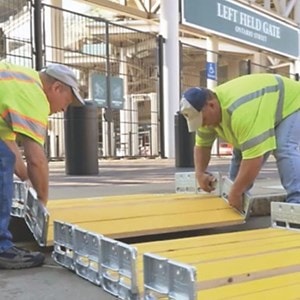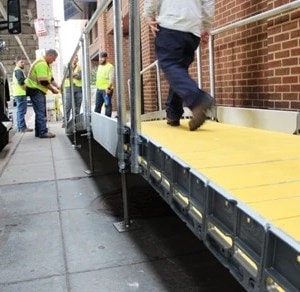Audible Information Devices and the MUTCD 11th Edition
As Audible Information Devices (AID) become more common, regulations from the Department of Transportation will be updated to match the demand and need for this relatively nascent technology.
.png)
MUTCD to be adopted by every state in January 2026
The 11th Edition of the Manual on Uniform Traffic Control Devices (MUTCD) was published in December 2023 and went into effect January 2024. To give states enough time to adopt and implement the specifications in the manual, the Federal Highway Administration (FHWA), a division of the greater Department of Transportation (DOT), allotted states two years from when the ruling went into effect to “adopt the MUTCD or have a State MUTCD/supplement that is in substantial conformance with the MUTCD.” The deadline for states to adopt this updated ruling is January 18th, 2026.
Among the updates, the addition of Audible Information Devices (AIDs) guidelines is one of the most noteworthy. AIDs, as defined by Accessible Design for the Blind are devices that are “intended to provide information to pedestrians with visual disabilities that is equivalent to visual signing for notification of sidewalk closures and to indicate a temporary path around a construction area, using a speech message.” In other words, AIDs deliver on Americans with Disabilities Act (ADA) compliance by providing the same pedestrian instructions that would be delivered by a written sign through audible communication, allowing blind and visually impaired (BVI) pedestrians more independence and agency in their navigation. This addition to visible signage shows a clear, conscious effort on part of the US government to increase accessibility for the blind and visually impaired community.
Some specific examples from the MUTCD include Section 6C.03, which states that areas “where pedestrians are detoured to a temporary traffic control signal, an accessible pedestrian signal provides information in non-visual formats (such as audible tones and/or speech messages, and vibrating surfaces) so that a pedestrian with vision disabilities can know when to cross the street along the alternate route.” The document goes on to state that “blocked routes, alternate crossings, and sign and signal information should be communicated to pedestrians with vision disabilities by providing devices such as audible information devices or barriers and channelizing devices that are detectable to the pedestrians traveling with the aid of a long cane or who have vision disabilities.” This update is significant as it appropriately addresses the needs of blind pedestrians using newer technology. Recent developments in audio technology have made AIDs practical, as they are more durable and reliable than ever before. By including this section, this latest edition of the MUTCD demonstrates a commitment to continued efforts to support ADA with advanced technology
To aid this effort, PSS has developed Parakeet, an audible information device that is not only MUTCD compliant, but its automatic volume adjustment, tamper resistant casing, and smart motion detection make Parakeet the most advanced AID on the market. Watch here to see Parakeet in action, just as the MUTCD intends.
In the newest, 11th Edition of the MUTCD there are eight instances of audible information devices (AIDs) being mentioned, recommended, or mandated. Below is a breakdown of the key points of these instances:
6C.02 – page 779 – line 11- E.
“Blocked routes, alternate crossings, and sign and signal information should be communicated to pedestrians with vision disabilities by providing devices such as audible information devices or barriers and channelizing devices that are detectable to the pedestrians traveling with the aid of a long cane or who have vision disabilities.”
6C.02 – page 779 – line 12
“Where pedestrians in TTC zones are routed on temporary pedestrian pathways, providing information in nonvisual formats (such as accessible pedestrian signals with audible tones and/or speech messages, and vibrotactile surfaces) aids pedestrians with vision disabilities so they can navigate the temporary pathway.”
Line 11 of section 6C.02, the MUTCD recommends both AIDs and pedestrian channelizers be used to aid members of the Blind, Visually Impaired (BVI) community where the established pedestrian path has been altered by a work zone. Further on, in line 12, the document elaborates on how non-visual signaling, in this case audio signals and vibrating surfaces, help pedestrians navigate these temporary pathways.
6C.03 – page 780 – line 06
“Because printed signs and surface delineation are not usable by pedestrians with vision disabilities, blocked routes, alternate crossings, and sign and signal information should be communicated to pedestrians with vision disabilities by providing audible information devices, tactile and/or vibrating surface devices, and barriers and channelizing devices that are detectable to pedestrians traveling with the aid of a long cane or who have vision disabilities.
This line states that printed signage is not sufficient for pedestrians with vision disabilities, and therefore pedestrian directions on signage should also be delivered via audible information devices.
6C.03 – page 781 – line 07
“The most desirable way to provide information to pedestrians with vision disabilities that is equivalent to visual signing for notification of sidewalk closures is a speech message provided by an audible information device. Devices that provide speech messages in response to passive pedestrian actuation are the most desirable. Other devices that continuously emit a message, or that emit a message in response to use of a push button, are also acceptable. Audible information devices might not be needed if detectable channelizing devices make an alternate route of travel evident to pedestrians with vision disabilities.
Line 07 continues to emphasize the importance of inclusive message delivery stating that an AID is the most desirable way to convey information to a BVI pedestrian. It goes on to elaborate, saying specifically that passively triggered AIDs (AIDs that do not require pedestrians to directly interact with them) are the best option for AID usage.
6P-28 – Page 914 – line 05
“SIDEWALK CLOSED CROSS HERE signs shall include audible information devices to provide adequate communication to pedestrians with vision disabilities.”
In this line, which refers to the above figure, the MUTCD uses the word “shall” to indicate that AIDs are mandated wherever “sidewalk closed” signage is placed (R9-9). In the example of this image, audible information devices shall be mounted on or near the provided visual signage.
6P-28 – Page 914 – line 06
“Audible information devices shall be provided where midblock sidewalk closings and changed crosswalk areas cause inadequate communication to be provided to pedestrians with vision disabilities.”
In reference to the same figure, use of “shall” is further used to indicate a required placement of AIDs wherever a sidewalk is closed midblock.
6P-29 – Page 916 – line 03
“SIDEWALK CLOSED CROSS HERE signs shall include audible information devices to provide adequate communication to pedestrians with vision disabilities.”
In reference to the above figure, which is a different style of work zone, this line mandates the use of AIDs where “sidewalk closed” (R9-9) signs are present. In the example of this image, audible information devices shall be mounted on or near the provided visual signage.
6P-29 – Page 914 – line 04
“Audible information devices shall be provided where midblock sidewalk closings and changed crosswalk areas cause inadequate communication to be provided to pedestrians with vision disabilities.”
Referring to the same figure, use of “shall” is further used to indicate a non-optional placement of AIDs wherever a sidewalk is closed midblock.
Related Articles
-
 The Traffic Safety Cone Has Been In Use For Decades – Here's How It Got Reinvented
The Traffic Safety Cone Has Been In Use For Decades – Here's How It Got Reinvented -
 4 Ways a Portable Pedestrian Ramp Makes the Community more Accessible
4 Ways a Portable Pedestrian Ramp Makes the Community more AccessibleEveryone wants a more accessible community. But the reality is that all communities have unique obstacles that create barriers for those who do not have the same mobility abilities as others. For exam...
-
 INNOVATIVE RAMP PROVIDES ACCESSIBILITY TO SIDEWALK OBSTRUCTION IN D.C. WORK ZONE
INNOVATIVE RAMP PROVIDES ACCESSIBILITY TO SIDEWALK OBSTRUCTION IN D.C. WORK ZONEA residential building in an area with heavy foot traffic needed maintenance, but the tools and machinery needed for the project created a tripping hazard. Closing the sidewalk was not an option so PS...